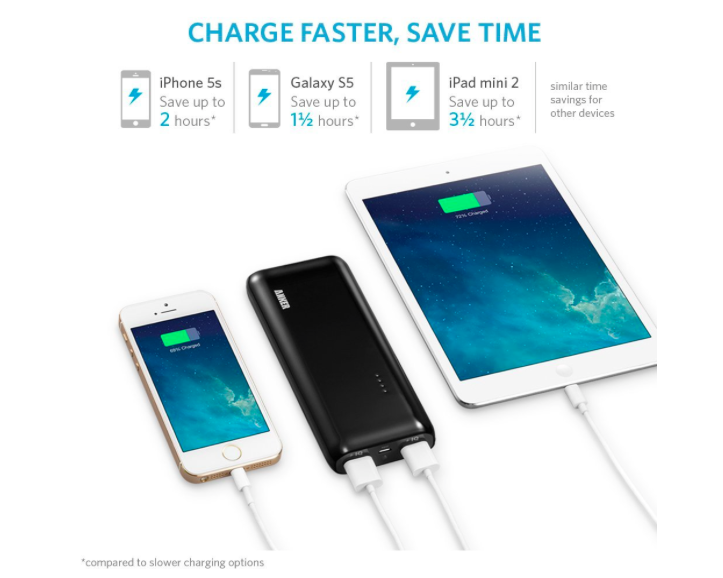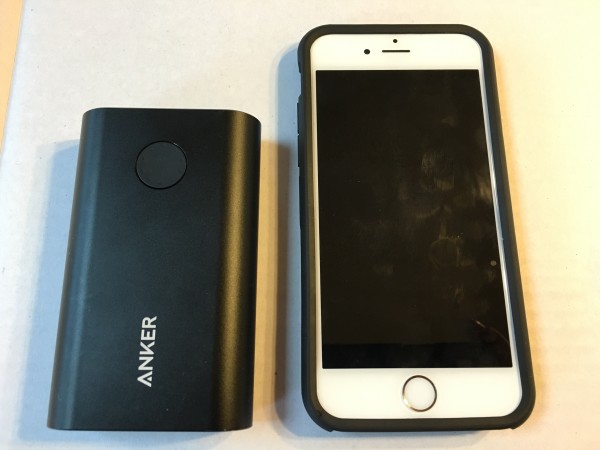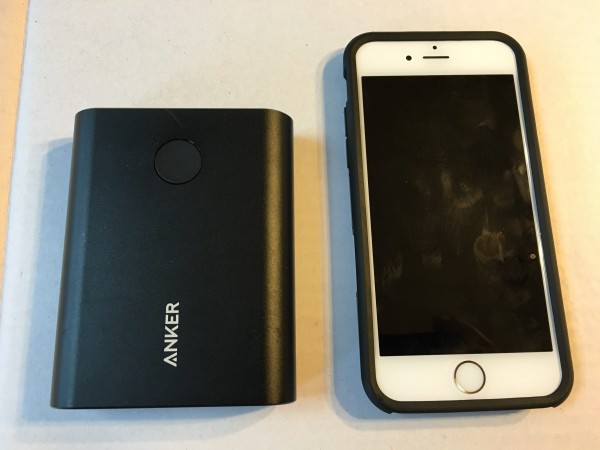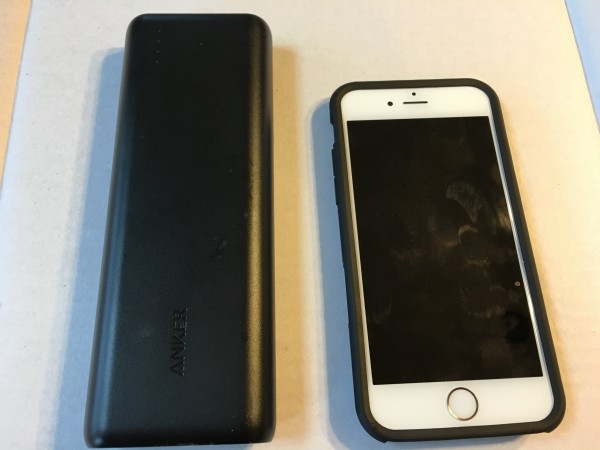A Comprehensive Guide To How Much An Anker External Battery Actually Charges

The old saying “knowledge is power” has been flipped the other way in the smartphone generation. No power for your smartphone? That’s a problem for many folks. I’ve been carrying a portable battery for quite some time, and I’m partial to the Anker brand of batteries. Having tested others, I like their form factor and I haven’t seen any decrease in the charging capacity of the ones I use.
A thought occurred to me as I was testing the form factor of their new batteries to see what fit well in my backpack. I’ve seen the “estimated charging capacity” of batteries, and I notionally know if I can get a charger or more than one charge out of a battery. But, I’ve never really figured out how accurate those estimates are. So, I ignored those estimates and field tested each of the new batteries to see how much charging capacity each one actually had.
For this exercise I used my iPhone 6 and my iPad Air 2. General recommendations for charging an iPhone effectively are to charge when the phone is at less than 20% battery life. So, I powered away on my iPhone and recharged each time I was below 20%, adding up the “cumulative percentage” I was able to charge for each battery. I’m a power user of my iPhone when it comes to e-mail (and even social media from time to time). I keep my screen brightness fairly high though not all the way up. Those things likely impacted my numbers at least a little bit.
Results are listed below with some pictures here and there to see the sizing. The links are Amazon referral links for me. If you find the information useful and decide to buy one of these batteries, I appreciate you clicking on my link. I did not receive free batteries or any other compensation from Anker for this post.
Anker PowerCore+ 10050 (10,000 mAh) Charger:
So you can get an idea of form factor on each battery, I’ve taken pictures of them beside an iPhone 6 (with a slim Seidio case).
The Anker 10050 is shorter than an iPhone. It fits easily in your hand and has one charging port on it for pretty much anything that can be charged with a USB power cord. It weighs about 11 ounces. For comparison, an iPhone 6 weighs about 5 ounces.
Anker rates this unit as able to charge an iPhone 6 almost 4 times. It depends on how you determine such things, since most people won’t let their phone run all the way dead. I got an average of 304 percentage points by charging it when the battery life on my iPhone dropped to 20% or less and disconnecting the cable when I was over 95%. 400% would be 4 full charges here, but you’re not realistically going to let your phone die, and I was using my phone while charging. I’m something of a power user on my phone, so I’m sure I consumed battery life while charging. Given all those factors, I would rate Anker’s statement of charging up to 4 times as reasonably accurate.
I tested the 10050 on my iPad as well. I charged my iPad Air when it fell below 10% total charge and got on average 86 percentage points of power. In other words, this battery is capable of recharging a standard iPad Air one time. Given that the iPad can last up to 10 hours on one charge, that’s a lot of extra battery life.
The 10050 comes with Qualcomm quick charge technology (not all Anker chargers do at this time) which can be useful if you need to charge your battery quickly.
Amazon sells this unit for $29.99 right now, which is $3 less than what I paid for it when I bought it a bit over a month ago. Given that most lipstick chargers are going to cost you $10-$20 (other than the really crappy ones for under $10) I consider this a good deal. And, when you consider $20 can also buy you a suspect charger like the Fuel Rod, you can see why I value Anker’s products so highly.
Anker PowerCore+ 13400 (13,400 mAh) Charger:
The 13400 is shorter than an iPhone but fatter. It’s a bit awkward to hold width-wise in your hand but can be held with reasonable comfort. It has 2 charging ports so you can charge two devices at once. It can provide 2.5 amps per port, which means you can charge a tablet and a phone at the same time at max charging speeds.
I consistently received between 440 and 450 percentage points of charging from this batter on my iPhone 6 (or about 4.5 charges). Anker advertises up to 5 charges. Again, reasonably accurate given my style of usage.
I received about 110 percentage points of juice on my iPad Air, or enough to charge it once pretty fully and still mostly charge my iPhone. That makes this a good, somewhat compact battery for power users of both a phone and tablet. The 13400 weighs about 14 ounces, where an iPhone 6 weighs about 5 ounces.
Amazon is selling this battery for $39.99. That’s what I paid for it a month ago. That’s a reasonable price for a battery that can power two things at once. If you don’t need to charge two at once, the 10050 is probably fine for your needs.
Anker PowerCore 20100 (20,000 mAh) Charger:
This battery has an interesting form factor. Taller and thinner than the iPhone, it can be easy to carry (or tuck in the back pocket of your jeans, like I did).
Anker advertises that it will charge an iPhone 6 7 times. I consistently got 680-720 percentage points of charge, an obscene amount of charging. Given my habits, I’d guess you might be able to get more than 7 charges out of this battery. It came about 20% short of filling my iPad Air twice (about 180 percentage points of charging). It weighs less than the 13400 at just under 13 ounces, or a little less than a can of soda. It has two charging ports like the 13400 and both ports can handle a tablet a 2.4 amps each.
It’ll take overnight to recharge this battery once you deplete it, but let’s be realistic. That’s a lot of charging power.
Amazon sells it for $39.99, the same price as the 13400.
Which Battery is Right For You?
I have an older Anker 6700 mah that’s my every day battery. It’s the previous generation so it charges a bit slower, but the form factor works for a specific pouch in my backpack. I purchased each of these to figure out which one I wanted to replace it and figured I would give the other ones to employees who need such things.
The 10050 is a device that charges (and recharges itself) quickly. I prefer the form factor of the 6700 to this one a bit more, but it’s a good every day battery for folks who need more than a lipstick charger (especially when you consider they’re in the $13 range versus $20 for the much larger 10050).
For me, I’d choose the 20100 over the 13400 mostly based on form factor. The 13400 is fine and likely works for people carrying it in their hand. But, I have a long slim pouch on the side of my backpack that the 20100 works well in and still allows me to get a bottle of water in the netting outside due to its slimmer profile.
Just a reminder, I received no compensation or cajoling from Anker to write this review. I like Anker batteries above all others I’ve tried. And, if I was really trying to milk this for the Amazon referrals, I would have posted this back on Black Friday when you had plenty of shopping left to do for the holidays (though Amazon Prime customers probably could still get some of these by tomorrow). For anyone who chooses to use my links, I do appreciate it. A fair amount of time went into documenting the various charging times in an effort to produce useful information for those trying to evaluate manufacturer claims.
The post A Comprehensive Guide To How Much An Anker External Battery Actually Charges appeared first on Pizza in Motion.



